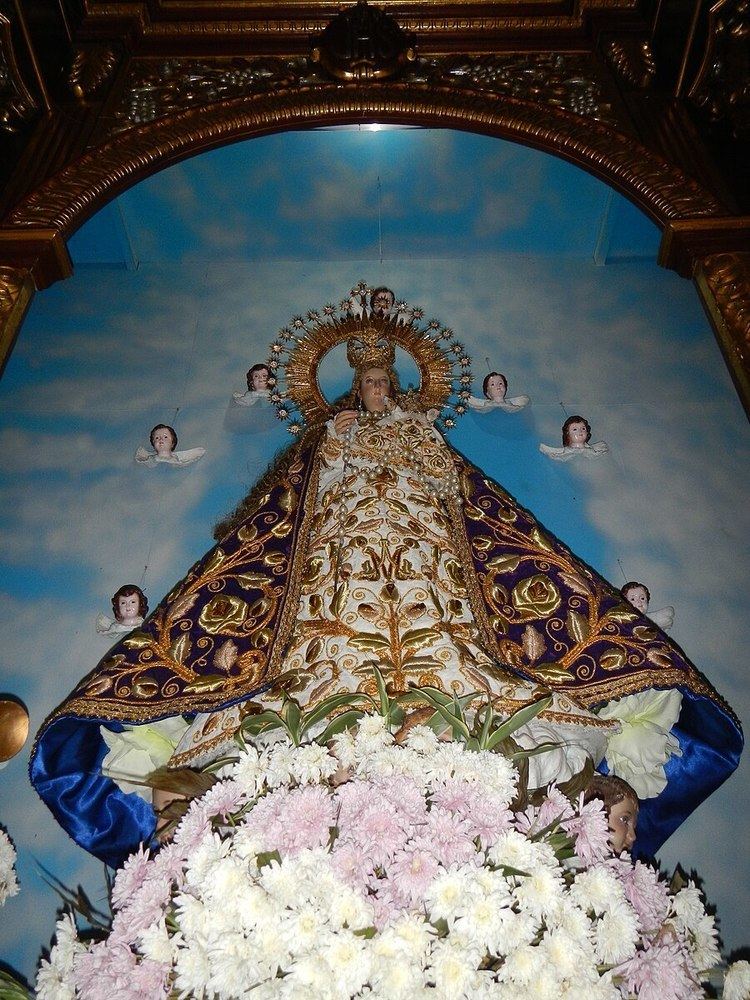Functional status Active Completed 1981 Groundbreaking 1940 | Denomination Roman Catholic Architectural type Church building Opened 1981 Archbishop Luis Antonio Tagle | |
 | ||
Similar Sub‑Parish Church of Santo Cri, Saint Augustine Parish Ch, Malolos Cathedral, San Diego de Alcala Church, San Juan Bautista Church | ||
The Our Lady of Most Holy Rosary Parish Church (Spanish: Iglesia Parroquial de Nuestra Señora del Santísimo Rosario), commonly known as Makinabang Church or Bisitang Pula, is a Roman Catholic Marian church in Barangay Makinabang, Baliuag, Bulacan, Philippines. It is one of four Roman Catholic parish churches in the municipality and is the focus of one of its largest processions each year on October 7. The other nearby Baliuag parishes which bound the church are: Saint Augustine Church (Población); Holy Family Parish (Tangos); and Our Lady of Mount Carmel (Sabang). The church is also about 2 miles from its neighbor, Sub-Parish Church of Sto. Cristo in barangay Santo Cristo.
Contents
Makinabang Church is under the Vicariate of Saint Augustine of Hippo and belongs to the Roman Catholic Diocese of Malolos, a suffragan of the Archdiocese of Manila. Its incumbent Team of priests in solidum moderator is parish priest (Judicial Vicar), Fr. Winniefred F. Naboya, JCL., who was formally installed on November 27, 2013. Fr. Naboya recently replaced the former Parish Administrator, the late Msgr. Macario R. Manahan, who succeeded the late Fr. Walderedo Castillo who died in 2008. The Parish Church's Vicar Forane is Msgr. Filemon M. Capiral, HP.
Etymology
Before the 1521-1898 Spanish colonization of the Philippines), Makinabang was already a settlement or sitio and the largest in Baliuag. When the Spanish friars, particularly the Augustinians, founded Saint Augustine Church in 1733, a Spanish Spanish mestizo introduced a wood sugarcane press to the area. The machine extracted panutsa (molasses), which the villagers mixed in with their coffee and other foods. Natives called the press makina (from the Spanish maquina), at which they would queue and abáng (Tagalog, "wait"). Those queuing would enquire "Marami pa bang nakaabang?" ("Are there many more waiting?), from which the word Makina-bang and eventually Makinabang was formed.
The chapel and its fence were originally painted red, for which reason the parish was called Bisitang Pula ("red chapel").
History
The church was built in 1941 and is devoted to its patron, the Nuestra Señora del Santísimo Rosario. Our Lady of the Rosary also known as "Our Lady of the Most Holy Rosary" is a title of the Blessed Virgin Mary in relation to the Rosary.
The devotion is traced back to the year 1571, when Pope Pius V instituted "Our Lady of Victory" as an annual feast to commemorate the victory in the Battle of Lepanto. The victory was attributed to the Blessed Virgin Mary, as a rosary procession had been offered on that day in St. Peter's Square in Rome for the success of the mission of the Holy League to hold back Muslim forces from overrunning Western Europe. In 1573, Pope Gregory XIII changed the title of this feast-day to "Feast of the Holy Rosary". This feast was extended by Pope Clement XI to the whole of the Latin Rite, inserting it into the General Roman Calendar in 1716, and assigning it to the first Sunday in October. Pope Pius X changed the date to 7 October in 1913, as part of his effort to restore celebration of the liturgy of the Sundays.
In 1940, before the outbreak of World War II, the parish priest Pastor Luciano (d. 1985) and later succeeded by Jovito Reyes, suggested to the higher Church authorities in Bulacan, to build a small ermita or Kapilya. The new parish covered the Barangays of Tarcan, Santa Barbara, and even Taal and Santo Cristo in Pulilan, Bulacan. The small chapel is made of wood, nipa and light building materials, while its attached convento was made of nipa.
Fr. Jovito Reyes reconstructed the dilapidated chapel, adding concrete buttresses, including the walls, roof and convento. Wealthy residents, headed by Councilor Carmen Fernando García, Delfin Cruz and Salud S. Tesoro, helped build the new patio and grotto of the Sagrada Corazón and Our Lady of Lourdes.
Fr. Amador Wisco Cruz (called Fr. Amador by the parishioners) succeeded Fr. Jovito as parish priest on July 20, 1957. He bought the 4,000 sq.m. lot wherein the parishioners built the Parish Hall of the Cursillistas and Catholic Women's League. He is also known as the translator/editor of the most popular version of the Pasyón (Copyright 1949), the "Casaysayan nang Pasióng Mahal ni Jesucristong Panginoón Natin na Sucat Ipag-alab nang Pusò nang Sinomang Babasa". In the early 1990s, Fr. Expedito Caleon and Fr. Jess Cruz assisted the then ailing Fr. Amador who died in the year 1992, after having served the parish for 35 years. Then, Fr. Ronald Ortega was appointed as Parish Administrator who was in turn succeeded by the late Fr. Walderedo Castillo (who died in 2008) and who in turn was succeeded by the late Msgr. Macario R. Manahan (who died in 2013).
On October 7, 2011, the Parish (Pastoral Council Executive Committee and PASKA) Church celebrated its Sapphire Jubilee. In preparation for the 75th Year Jubilee celebration come October 2016, the Parish Pastoral Council which is currently being headed by the Parish Priest himself, Fr. Winniefred F. Naboya, J.C.L., is initiating repairs and improvements of the church building and its environs.
